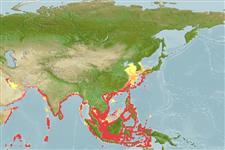>
Scombriformes (Mackerels) >
Trichiuridae (Cutlassfishes) > Lepidopodinae
Etymology: Eupleurogrammus: Greek, eu = good + Greek, pleura = near, on the side + Greek, gramma = mark, signal (Ref. 45335).
More on author: Gray.
Environment: milieu / climate zone / depth range / distribution range
Écologie
marin; saumâtre benthopélagique; profondeur 0 - 80 m (Ref. 6181). Tropical; 41°N - 11°S, 47°E - 135°E (Ref. 6181)
Indo-West Pacific: including the Persian Gulf, India, Sri Lanka, Malaysia, Indonesia, Gulf of Thailand, China and southern Korean Peninsula.
Taille / Poids / Âge
Maturity: Lm ? range ? - ? cm
Max length : 87.0 cm TL mâle / non sexé; (Ref. 112044); 97.5 cm (female); common length : 50.0 cm TL mâle / non sexé; (Ref. 9688)
Épines dorsales (Total) : 3; Rayons mous dorsaux (Total) : 140. Body extremely elongate, compressed and tapering to a point. Anal fin reduced to minute spinules buried in skin; caudal fin absent; pelvic fins present but reduced to a scale-like process. Lateral line running almost straight along midbody or slightly nearer the ventral contour. Color of fresh specimens steely blue with metallic reflections, becoming silvery gray after death.
Inhabits coastal waters and often comes near the surface at night. Enters estuaries (Ref. 1479). Feeds on a wide variety of small fishes, squids and crustaceans. Marketed mainly in dried and salted forms (sometimes fresh), mixed with other trichiurids. Caught mainly with shore seines, bag nets and coastal bottom trawls in coastal waters down to about 50 m in West Bengal to Madras and around Bombay of India.
Life cycle and mating behavior
Maturité | Reproduction | Frai | Œufs | Fécondité | Larves
Nakamura, I. and N.V. Parin, 1993. FAO Species Catalogue. Vol. 15. Snake mackerels and cutlassfishes of the world (families Gempylidae and Trichiuridae). An annotated and illustrated catalogue of the snake mackerels, snoeks, escolars, gemfishes, sackfishes, domine, oilfish, cutlassfishes,. scabbardfishes, hairtails, and frostfishes known to date. FAO Fish. Synop. 125(15):136 p. (Ref. 6181)
Statut dans la liste rouge de l'IUCN (Ref. 130435: Version 2024-2)
Menace pour l'homme
Harmless
Utilisations par l'homme
Pêcheries: commercial
Outils
Articles particuliers
Télécharger en XML
Sources Internet
Estimates based on models
Preferred temperature (Ref.
123201): 24.3 - 29.1, mean 28.4 °C (based on 1170 cells).
Phylogenetic diversity index (Ref.
82804): PD
50 = 0.7500 [Uniqueness, from 0.5 = low to 2.0 = high].
Bayesian length-weight: a=0.00033 (0.00020 - 0.00054), b=3.20 (3.06 - 3.34), in cm total length, based on LWR estimates for this species & (Sub)family-body (Ref.
93245).
Niveau trophique (Ref.
69278): 4.1 ±0.7 se; based on diet studies.
Résilience (Ref.
120179): Haut, temps minimum de doublement de population inférieur à 15 mois (Preliminary K or Fecundity.).
Fishing Vulnerability (Ref.
59153): Moderate to high vulnerability (48 of 100).
Nutrients (Ref.
124155): Calcium = 96.2 [48.9, 173.9] mg/100g; Iron = 0.923 [0.467, 1.688] mg/100g; Protein = 17.8 [16.3, 19.4] %; Omega3 = 0.162 [0.081, 0.352] g/100g; Selenium = 85.5 [42.2, 182.5] μg/100g; VitaminA = 17.8 [5.0, 50.9] μg/100g; Zinc = 0.981 [0.667, 1.547] mg/100g (wet weight);
